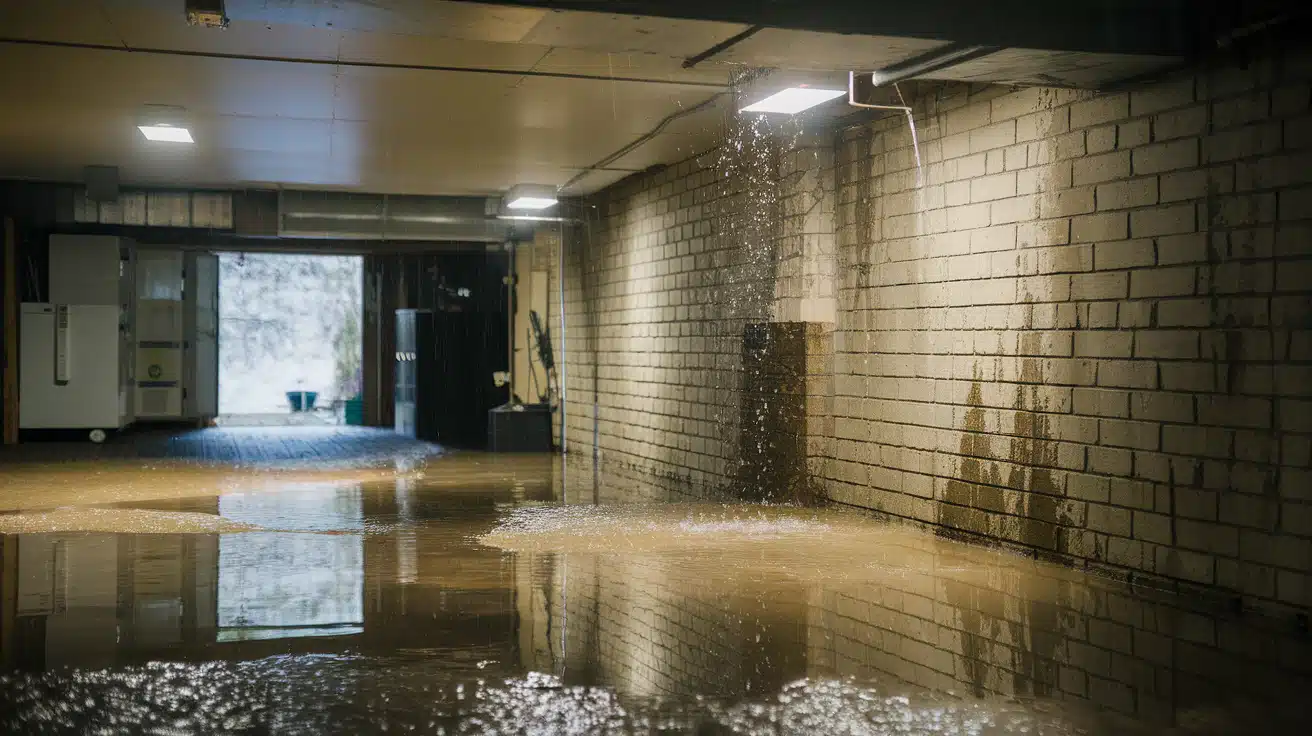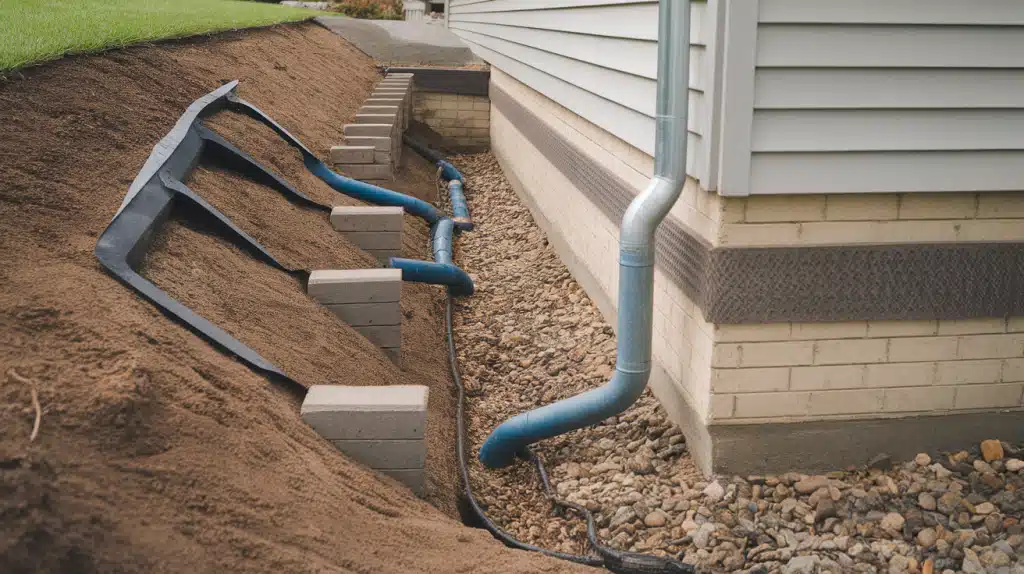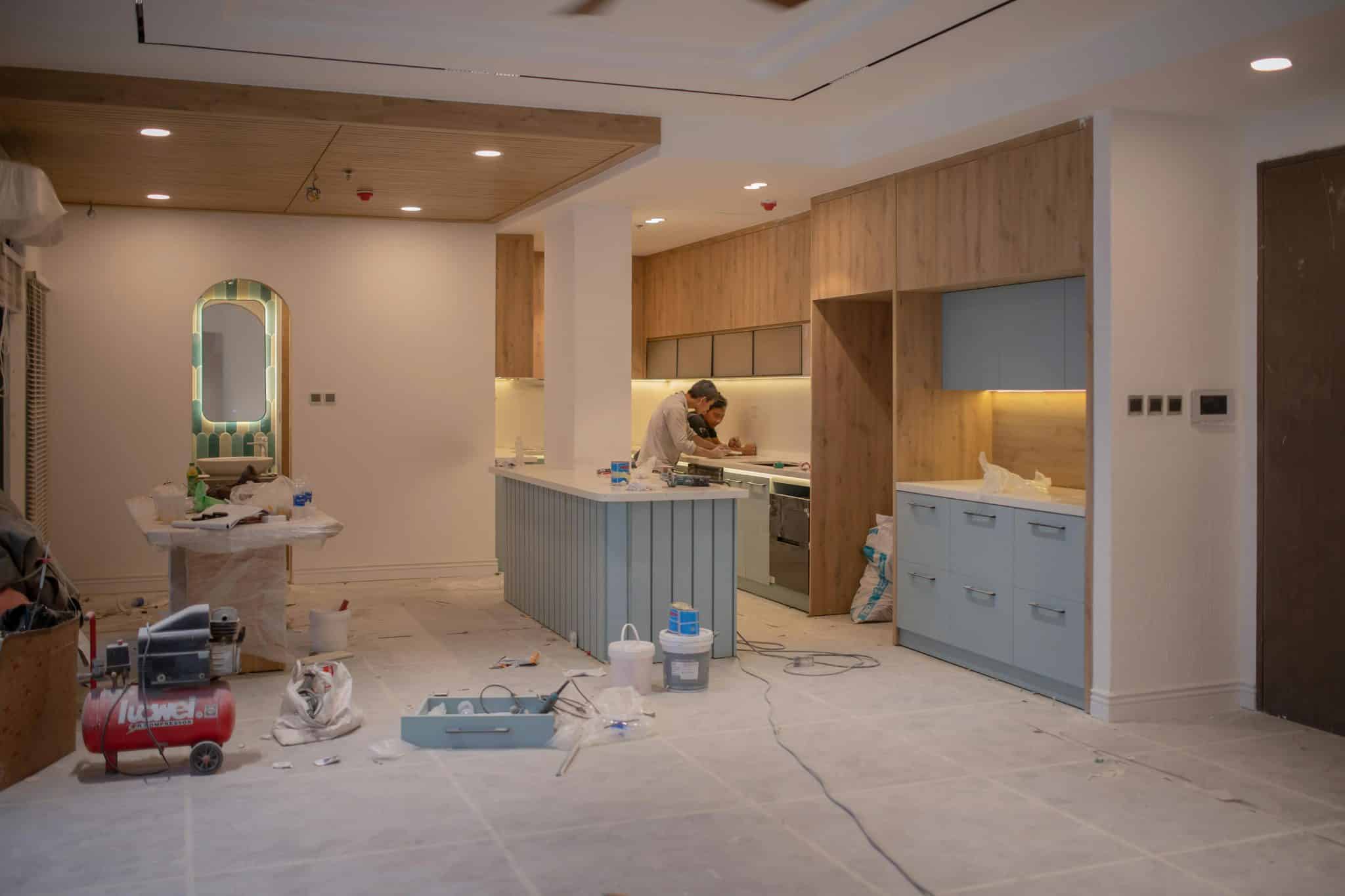Nothing ruins your day like walking downstairs to find water pooling in your basement. Heavy rain turns thousands of dry basements into soggy disaster zones every year.
That musty smell, those damp walls, and the constant worry about mold growth are every homeowner’s nightmare.
They get worse with every storm. What starts as a small, damp spot can quickly escalate into significant structural damage, ruined belongings, and serious health hazards due to mold growth.
But there’s good news. Most basement water problems have clear causes and proven solutions.
You can identify warning signs early, locate the source of leaks, and take action before minor issues escalate into expensive disasters.
This guide shows you exactly how to protect your basement from water damage and keep your home safe and dry.
Why Basements Leak After Rain?
Heavy rain turns your basement into a nightmare zone. When storms hit, water finds every weak spot in your foundation. The soil around your home gets soaked.
This creates massive pressure that pushes water through tiny cracks and gaps. Your drainage systems get overwhelmed.
Window wells fill up like bathtubs. The ground can’t handle all that water, so it goes straight into your basement.
Think of it like this: your basement sits underground, surrounded by wet soil after a storm. Water always finds the most straightforward path downward.
If your home’s defenses aren’t strong enough, that path leads right through your foundation walls and floor.
Main Reasons Water Gets Into Your Basement
- Hydrostatic Pressure – Saturated soil creates enormous pressure that forces water through foundation walls and floors like a hydraulic press.
- Foundation Cracks – Even hairline cracks become water highways when soil pressure builds up during heavy rainfall.
- Poor Drainage Systems – Clogged gutters, broken downspouts, and improper grading send water straight toward your foundation instead of away from it.
- Window Well Issues – Faulty or clogged window wells turn into water collection pools that seep directly into basement windows.
- The Clay Bowl Effect – Backfilled soil around foundations acts like a bowl, trapping water right against your basement walls.
Signs You Have a Basement Water Leak
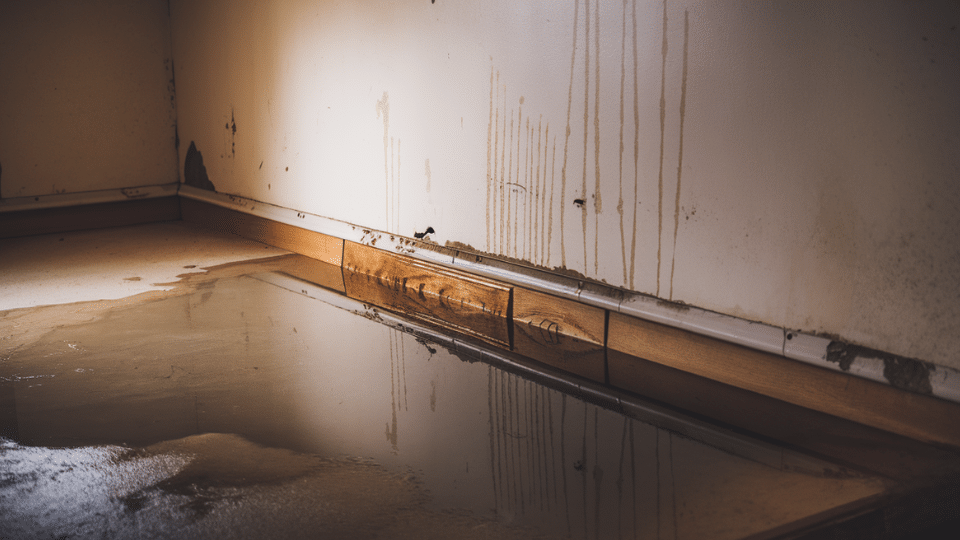
Your basement provides warning signs of potential damage before it becomes significant. Most homeowners miss these early clues until it’s too late.
Learning to spot these signals can save you thousands in repairs and protect your family’s health.
1. Visible Water on Walls and Floors
You’ll see dark patches or wet areas that shouldn’t be there. These spots often appear after storms or during periods of high humidity. Check corners, cove joints, and areas near windows first.
2. Musty Odors and Mold Growth
A basement shouldn’t smell like an old cave or gym locker. That musty smell means moisture is feeding mold and mildew. Look for black, green, or white fuzzy growth on walls, furniture, or stored items.
3. Peeling Paint or Efflorescence
Paint bubbles and peels when water gets behind it. White, chalky deposits on concrete walls indicate the presence of mineral salts from water seepage. These minerals get left behind when water evaporates through your foundation.
4. Increased Humidity or Condensation
Your basement feels sticky or damp even on dry days. Windows fog up easily, and metal items start rusting faster. You might notice condensation on pipes, walls, or your water heater.
5. Water Stains Around Windows, Doors, or Cove Joints
Brown or yellow stains mark where water has been entering repeatedly. These stains often appear as rings or streaks near basement windows and doors. Cove joints (where walls meet floors) show staining from groundwater pressure.
How to Identify the Source of the Leak?
Finding the leak source requires detective work, but it’s not complicated. Start by inspecting interior and exterior walls for visible cracks, gaps, or damaged areas where water might enter.
Next, check your gutters, downspouts, and drainage systems for clogs, damage, or improper water flow away from your foundation.
Examine window wells and basement windows for standing water, damaged seals, or blocked drainage. Finally, perform a condensation test by taping plastic wrap to a damp wall.
If moisture appears on the room side, you have a humidity problem; if it appears on the wall side, you leak.
This step-by-step approach helps you pinpoint exactly where water is entering, so you can address the right issue.
How to Permanently Prevent Basement Leaks
Tired of recurring basement water problems? Learn proven, long-term strategies to keep your basement dry, regardless of the intensity of the rain.
Exterior Solutions
1. Improve Grading: Ensure Soil Slopes Away from the Foundation. Your yard should slope away from your house at least 6 inches over 10 feet. This simple fix prevents water from pooling around your foundation during heavy rains.
Use clean fill dirt to build up low areas and create proper drainage paths. Most basement water problems begin with poor grading that directs water directly toward your foundation instead of away from it.
2. Install/Repair Gutters and Downspouts: Direct Water at least 6 Feet from the House. Clean gutters and working downspouts are your first line of defense against basement leaks.
Clogged gutters overflow and dump water right next to your foundation walls. Install downspout extensions to carry water at least 6 feet away from your house. Consider adding splash blocks or buried drain pipes for even better water control.
3. Exterior Waterproofing: Apply Waterproof Membranes and Drainage Boards. Professional exterior waterproofing creates a barrier between your foundation and wet soil.
Workers excavate around your foundation and apply rubber membranes or spray-on coatings. Drainage boards help water flow down to the footer drains instead of pressing against your walls. \
4. French Drains/Drain Tile Systems: Redirect Groundwater Away from the Foundation. French drains intercept groundwater before it reaches your foundation walls.
These systems use perforated pipes surrounded by gravel to collect and redirect water away from your home.
Footer drains work similarly but are installed at the foundation base during the construction process.
Interior Solutions
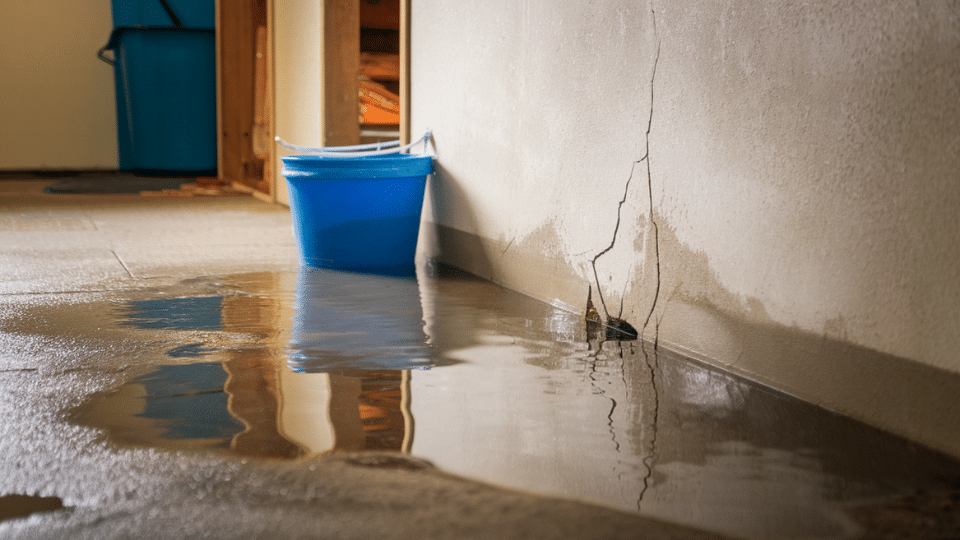
1. Seal Foundation Cracks: Use Professional-Grade Sealants or Epoxy Injections. Small cracks need immediate attention before they become significant problems.
Professional sealants and epoxy injections create waterproof barriers that stop water from seeping through foundation walls.
These materials expand and contract with your foundation, preventing new cracks from forming. DIY crack repair kits are suitable for minor issues, but hiring professionals is recommended for cracks wider than 1/8 inch.
2. Install a Sump Pump: Remove Water That Enters the Basement. A sump pump acts as your basement’s last line of defense against flooding.
The system collects water in a pit and pumps it away from your home before it can cause damage. Battery backup systems continue to function during power outages when you need them most.
Install the pump at the lowest point in your basement for maximum effectiveness.
3. Interior Waterproofing Coatings: Apply Moisture Barriers to Walls and Floors. Interior waterproofing coatings create a moisture barrier on basement walls and floors.
These products seal minor cracks and reduce humidity levels in your basement space. Apply coatings to clean, dry surfaces for best results and reapply every few years.
While less effective than exterior solutions, interior coatings provide affordable protection for minor water issues.
4. Dehumidifiers: Control Basement Humidity. High humidity creates the perfect environment for mold growth and structural damage. Basement dehumidifiers remove excess moisture from the air, helping to prevent condensation problems.
Choose units rated for your basement’s square footage and empty collection tanks regularly. Proper ventilation combined with dehumidification keeps your basement dry and healthy.
Basement Leak Repair & Prevention Cost
| Solution | DIY Cost | Pro Cost |
|---|---|---|
| Crack Sealing | $50 – $150 | $500 – $1,200 |
| Sump Pump Installation | $150 – $350 | $800 – $2,500 |
| French Drain | N/A | $2,000 – $6,000+ |
| Exterior Waterproofing | N/A | $5,000 – $15,000+ |
| Interior Waterproofing | N/A | $1,500 – $5,000+ |
| Gutter/Downspout Fix | $100 – $300 | $300 – $1,000 |
When to Call a Professional?
Some basement water problems are too big for DIY fixes and require expert help. Call a professional immediately if you have persistent leaks despite your DIY efforts.
This means the problem is more complex than surface-level repairs. Large or growing foundation cracks signal serious structural issues that need professional assessment and repair before they worsen.
Signs of structural damage or mold infestation pose health risks and require specialized equipment and expertise to handle safely.
Finally, suppose you require advanced waterproofing systems, such as exterior excavation, sump pump installation, or comprehensive drainage solutions.
In that case, professionals possess the necessary tools and experience to complete the job correctly the first time.
Summing It Up
Basement water leaks after heavy rain don’t have to be your worst nightmare. You now understand the primary causes, ranging from hydrostatic pressure to inadequate drainage systems.
You can spot the warning signs early, from musty odors to peeling paint. Most importantly, you have a clear action plan with both DIY solutions and professional options.
Remember, every day you wait makes the problem worse. Water damage spreads quickly, and mold can start growing within 24 hours.
Take action now to protect your home, belongings, and family’s health. The investment in proper waterproofing today saves you thousands in damage repairs tomorrow.
Ready to fix your basement water problems? Contact a local basement waterproofing expert for a professional inspection and restore your home to its safe, dry state.
Frequently Asked Questions
How Serious Is Water Seepage in a Basement?
Very serious – it causes structural damage, mold growth, and expensive repairs if ignored.
How Much Does It Cost to Fix a Basement Leak?
Costs range from $500 to $2,000 for crack sealing to $10,000 to $25,000 for full waterproofing.
Why Is Water Coming up From the Ground After Heavy Rain?
Heavy rain saturates soil faster than it drains, raising the water table and forcing water upward.

